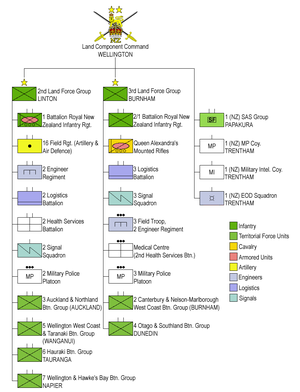Table of organization and equipment
This article includes a list of general references, but it lacks sufficient corresponding inline citations. (April 2016) |

A table of organization and equipment (TOE or TO&E) is the specified organization, staffing, and equipment of units. Also used in acronyms as 'T/O' and 'T/E'. It also provides information on the mission and capabilities of a unit as well as the unit's current status.
A general TOE is applicable to a type of unit (for instance, infantry) rather than a specific unit (the 3rd Infantry Division). In this way, all units of the same branch (such as Infantry) follow the same structural guidelines.
Soviet Union and Russia
In the Soviet and the Russian Armed Forces the term used for TO&E since the 1930s is "Shtatnoe raspisanie" (Штатное расписание,[1] literally translated as Shtat Prescription). It originates from the term "Shtat" (штат)[2] which is used primarily to denote manpower and in a secondary meaning as the synonym for TO&E itself. Note that in the Soviet Union and modern day Russia the term "Shtatnoe raspisanie" applied not only to military unit, but also to state organisations such as ministries, agencies, universities, hospitals etc. and even to the corporate structure of private companies.
Many of the Red Army's rifle divisions at the beginning of Operation Barbarossa were operating on Shtat 04/400 of 5 April 1941.[3] This Shtat stipulated that an infantry division should consist of three infantry regiments, a light and a howitzer artillery regiment, other artillery units, a reconnaissance battalion, a combat engineer battalion, signals, chemical company (decontamination/flamethrower), transport, medical, and logistics train units, an aviation flight, and a division staff seemingly consisting of the division commander (1/0/0), division staff (70, including 12 horses and 13 vehicles), a quartermaster section of five officers (5/0/0), a military tribunal (military justice) of two officers, and a political section of 11 officers.
Soviet rifle divisions were often forced to operate at far below their authorised strengths. For example, in the middle of the fighting on the Eastern Front, on July 20, 1942, a report on the 284th Rifle Division lamented:[4]
"In the division there are 3,172 military servicemen; a batch of replacements numbering 1,312 men has arrived and another 2,000... are expected, but in the division there are only a total of 1,921 rifles, 98 [semi-]automatic rifles and 202 PPSh submachine guns... There are 21 motorized vehicles in the division, but according to the shtat there should be 114. There are just 7 heavy machine guns, but according to the shtat 108 are necessary. 47 light machine guns, but according to the shtat there should be 350. 36 anti-tank rifles, but 277 according to the shtat. The division's separation from its supply base extends up to 100 kilometres and aggravates the supply [of] food."
The commissar, Tkachenko, went on to urgently request vehicles (including ambulances, of which there were none), small arms and support weapons, draught horses, and a closer supply base. After the first day of fighting he further reported that the lack of high-explosive shells forced the artillery to fire armor-piercing rounds at enemy firing points and troops; there were no cartridges for the submachine guns; many of the men's uniforms and footwear were worn out; and it was impossible to commit the replacements into the fighting because of the lack of weapons.
United States Army
In the U.S. Army, there are four basic types of TOEs:
- The Base Table of Organization and Equipment (BTOE)
- An organizational design document based on current doctrine and available equipment. It shows the basics of a unit's structure and their wartime requirements (both for personnel and equipment).
- The Objective table of organization and equipment (OTOE)
- An updated form of the BTOE, usually formed within the last year. It is a fully modern document and is up to date with current policies and initiatives.
- A Modification table of organization and equipment (MTOE)
- A document that modifies a Basic TOE (BTOE) in regard to a specific unit. Used when a unit's needs are substantially different from the BTOE.
- A Table of distribution and allowances (TDA)
- A type of temporary TOE that is applicable to a specific mission. Used in an instance when there is no applicable TOE.
Each TOE has a unique number that identifies it. When changes are needed, a table is not modified, instead, a new table is drafted from scratch.
United States Marine Corps
Marine T/O&Es are based on a generic template for each specific type and size of unit, for example, a weapons company of an infantry battalion, or a heavy helicopter squadron. These templates are then modified as needed by the individual unit. The Marine Corps also relies on other documents to report what personnel and equipment a unit actually possesses.
The T/O section denotes every authorized billet within a unit by rank and Military Occupational Specialty required to fulfill the necessary duties. The T/E section denotes authorized equipment by Line Item Number and quantity.
See also
References
- ^ Andrei Grechko, Marshal of the Soviet Union (1976). Советская военная энциклопедия [1976-1980], том 8 (Soviet Military Encyclopedia [1976-1980], Book 8). Moscow: Voenizdat [Воениздат], the official printing house of the Soviet Ministry of Defence. p. 537.
- ^ "Штат".
- ^ http://www.niehorster.org/012_ussr/41_organ/div_rifle/rd_00.html
- ^ Igor Sdvizhkov, Confronting Case Blue, ed. & trans. S. Britton, Helion & Co., Ltd., Solihull, UK, 2017, p. 26
